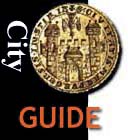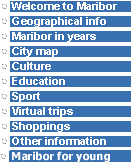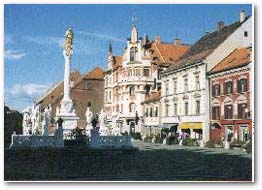

![]() Fine arts in
Maribor has kept pace with the ups and downs of the city.
From the earliest times written documents have not
survived about artists, sculptors, wood carvers, and
painters who adorned, for example, the old parish church,
presently the main Chatolic Church.
Fine arts in
Maribor has kept pace with the ups and downs of the city.
From the earliest times written documents have not
survived about artists, sculptors, wood carvers, and
painters who adorned, for example, the old parish church,
presently the main Chatolic Church.
![]() Creativity in
painting in Maribor was spurred on in the beginning of
the seventeenth century, before the influence of the
Baroque Period. Maribor witnessed a widespread revival of
fine arts in the Baroque Period - from the
mid-seventeenth
Creativity in
painting in Maribor was spurred on in the beginning of
the seventeenth century, before the influence of the
Baroque Period. Maribor witnessed a widespread revival of
fine arts in the Baroque Period - from the
mid-seventeenth  century. Since in this
period many new buildings were erected, mainly churches,
with the older ones being renovated in the new artistic
style, artists found work plentiful. Josef Straub
(d. 1757) came to Maribor from Ljubljana and, among other
works, created the Plague Memorial
in Maribor's Glavni trg (Main Square) in 1743, as
well as many other fine works throughout Slovene Styria.
During this time, the Maribor Baroque Period was refined
artistically and assumed a wider European perspective.
century. Since in this
period many new buildings were erected, mainly churches,
with the older ones being renovated in the new artistic
style, artists found work plentiful. Josef Straub
(d. 1757) came to Maribor from Ljubljana and, among other
works, created the Plague Memorial
in Maribor's Glavni trg (Main Square) in 1743, as
well as many other fine works throughout Slovene Styria.
During this time, the Maribor Baroque Period was refined
artistically and assumed a wider European perspective.
![]() In the nineteenth
century Maribor's interest in the fine arts waned;
Mariborian citizens, by now solidly middle-class,
preferred to have their portraits painted in the Biedermeyer
and flowing romantic fashion. They had their
portraits painted by numerous travelling painters or, in
the case of well-to-do families, by distinguished
painters from abroad.
In the nineteenth
century Maribor's interest in the fine arts waned;
Mariborian citizens, by now solidly middle-class,
preferred to have their portraits painted in the Biedermeyer
and flowing romantic fashion. They had their
portraits painted by numerous travelling painters or, in
the case of well-to-do families, by distinguished
painters from abroad.
![]() The plastic arts
became popular after World War I, when the Slovenes, in
the newly receptive political climate, wanted to elevate
the plastic arts as well.
The plastic arts
became popular after World War I, when the Slovenes, in
the newly receptive political climate, wanted to elevate
the plastic arts as well.
![]() The local residents
of Maribor keep in touch with
The local residents
of Maribor keep in touch with the arts through
numerous exhibitions organized by the Art
Gallery, together with the Rotovz Salon
they have their galleries in the Town Hall and in
Kraigherjev trg. Additionally, there are many local
exhibitions in bookstores, banks, schools, and private
galleries, where the art works are for sale. The city has
been enhanced with outdoor avant-garde creations in
concrete by sculptors from abroad. These sculptors met at
the international symposia Forma Viva during 1967
- 1986.
the arts through
numerous exhibitions organized by the Art
Gallery, together with the Rotovz Salon
they have their galleries in the Town Hall and in
Kraigherjev trg. Additionally, there are many local
exhibitions in bookstores, banks, schools, and private
galleries, where the art works are for sale. The city has
been enhanced with outdoor avant-garde creations in
concrete by sculptors from abroad. These sculptors met at
the international symposia Forma Viva during 1967
- 1986.